Seeds and roots of wild plants as an extension of flour
© Satu Hovi 1998 / 2017
No part of this text is allowed to be cited or published without my permission. Please note that methods of research get better all the time, and new interpretations may appear.
Though people in Iron-Age Finland were tall, which means that they ate well, long and cold winters and uncertainty of the coming years forced them to pick everything edible from the nature. Iron-age Finland was very sparsly populated, unlike the rest of Scandinavia and England. If you could not find enough food and land to feed your family, you just moved a bit further inland.
Famine years were plenty in our history. There were also years with very meagre harvests. Famine could come the following year, you never knew, so people felt better if they had grain also for the next year. It makes sense that people collected seeds and other food staff from the nature to make sure they had enough food for the next winter. Wild seeds also gave variety to the taste of grain.
Ann Hagen investigated the famine years in England. At that time people and cattle died of hunger. For example in the 10th century years 900, 954 (beginning of a 4-year famine), 962, 969, 975, 976, 986, 988 and 989 were years of famine. (Processing & Consumption, p.152) Looks like famine was a common visitor on those days. Leechdoms mentions ten references to barley meal, one to fine barley meal, six to wheat, one to fine wheat meal, one to fine wheat flour, three to rye, one to oat meal, one to bean meal, acorn flour/powder, sieved hazel and alder flour. (Hagen, p. 14-15) The use of wild seeds - prehistory in Sweden
Isse Israelsson has written about prehistoric and Viking-Age archeological finds of pots full of wild seeds. This shows that wild plants were used and collected actively for food. Maybe people also raised plants which we don’t know are edible at all, just ’wild’ and ’ beautiful’. It is easy at least make more room to the plants you want to favor, if you are not eager to sew them into the corn fields you have made with a lot of work.
Israelsson has forgotten to use Latin names of the plants, which may cause confusion and uncertainty when translated. That is why I added Swedish names on the following list. In Jylland the archeologists found seeds of Fat Hen (svinmålla) close to pot pieces. In Denmark Smartweed seeds (pilört) and seeds of linen and dådra were found. Pots have been found with both wild seeds and grain mixed in, for ex. Bindweed (åkerfinda). Also Dock (syra) mixed with flour and ground Water Arum root (miss ne).
Water Arum root mixed with flour leavens the bread itself (Aaltonen, p. 17). Also root of Common Horsetail (åkerfräker) has been ground and added to bread flour. (Israelsson, p. 26-31).
English seed finds
A corpse of a man who died near the year 0 was found in England. He was well preserved and his last meals could be analyzed with the latest technique. From his stomach were found a variety of wild seeds, spelt wheat, emmer wheat and barley. The Archeologists could assist that the grain was eaten in a form of a bread. Wild seeds were from his latest meals. They were from the plants: Dock, (possible Rumex conglomeratus), Pale Persicaria (Polygonum lapathifolium), Fat Hen (Chenopodium album), Meldes (Atriplex sp) and Cow Parsley- family (Umbelliferae). Also there were a couple of leaves of Scots Heather (Calluna vulgaris), but they are assumed to be stayed in the bottom of the bread and came from the baking on fire. (Lindow man, p. 108)
Wild seeds in Finland
From a late Iron-Age living place in Paimio 448 seeds were found, mostly grain. One third were grain, most rye and barley, very little wheat and oat. According to Seppä-Heikka this kind of mix of barley and rye is typical for that time. From a ditch connected with a building from the time of the Finnish crusades (12th-13th. centuries) carbonized seeds of grass- and grain plants were found : Peas, Sedge, Vicia hirsuta, Stellaria graminea and Wild Basil. Close by a lot of seeds by various plants were found, which were used for human nutrition. (Seppä-Heikka).
People of the North and their wild flour
Toivo Rautavaara has written several books about the use of the wild plants in nutrition. The one in my bibliography is based on North, mainly Finnish, folk tradition. Knowledge passing from father to son cannot be reliable further than into the last half of the 19th century, but the use of wild plants is a lot older. I have chosen only those plants into the following list, which according to Hämet-Ahti grew in the Finnish continent about 1000 years ago. In Scandinavia people have used the following plants in both bread and porridge:
Allseed, seeds (Polygonum aviculare)
Alpine Bistort, roots and seeds (Polygonum viviparum)
Arrowhead, roots (Sagittaria sagittifolia)
Bilberry (Vaccinium myrtillus)
Bog bean, roots (Menyanthes trifoliata)
Broad-leaf Sorrel, seeds (Rumex acetosa)
Butomus umbellatus, roots
Caraway, seeds and roots as a spice (Carum carvi)
Cattail, roots and flower stamen (Typha latifolia)
Common Cattail, roots and flower stamen (T. angustifolia)
Clover, flowers (Trifolium)
Common Horsetail, Shave grass, roots (Equisetum arvense)
Common Polypody, roots (Polypodium vulgare)
Common Reed, Carrizo, roots (Phragmites communis)
Couch Grass, Twitch, roots (Agropyron, Elyttrigia repens)
Cowberry (Vaccinium vitis-idaea)
Cramp, Guelder rose, berries (Viburnum opulus)
Drop wort, corms (Filipendula hexapetala)
Fat Hen and Orach, seeds (Chenopodium album, Atriplex)
Fiddlehead Fern, roots (Pteridium aquilinum)
Fireweed, Rosebay, roots (Chamaenerium angustifolium)
Goat’s Beard, roots (Tragopogon pratensis)
Great Bulrush, Tule, roots (Scirpus lacuster)
Hawthorn, berries (Crataegus) Grows only in Aland and in the mainland cost
Iceland moss (Cetraria islandica)
Manna Grass, seeds (Glyceria fluitans)
Marsh Woundwort, corms (Stachys palustris)
Nympha, Pond Lily, roots (Nymphaea alba)
Scots Heather, flowers (Calluna vulgaris)
Silverweed, roots (Potentilla anserina)
Water Arum, roots (Calla palustris)
Wild Parsley, Cow-weed, roots (Anthriscus silvestris)
White Dead Nettle, dried leaves and young plants (Lamium album)
Yellow Water-Lily, roots (Nuphar lutea)
How to make flour from Island Moss
Island moss (Cetraria islandica) is said to be tasty by Rautavaara. Because it includes many mucus forming substances and carbohydrates, the bread raises well. Of course it can be added into porridge as well.
Anneli Schöneck makes her bread this way: Island moss can be collected from June to September, but only in sunny weather. When picking Island moss up, remember it grows back very slowly, in 5-10 years. Let it to dry. Cleaning is best done after soaking. Soaking for 12 hours gets part of its bitter taste disappear. If you like bitter taste, do not soak longer. Do not mix Island moss with soda though some information tells you to do so; it destroys the best of its taste. Before dough making in the morning, add the Island moss. Crash and mill it. Two hand fulls of Island moss is enough. (Schöneck, p.)

How to make flour from roots of Nympha (Nymphaea sp.)
People have used this method in Norway, and it really is good and tasty, Toivo Rautavaara recommends.
Wash, peel, cut up fine, dry and mill the roots. The flour has a bitter taste. To remove it wash the flour in cold water: put the flour and water into a baking tub. After some time, when the flour has gone down to the bottom and water is clear, pour the water carefully away and bake the flour. Do not use the Nympha flour into leavened bread, because when the leaven ferments, this flour fades away more than flour usually does. Use this flour to thin unleavened bread mixed with rye- or barley flour and flavour with caraway seeds instead. (Rautavaara, p. 82)
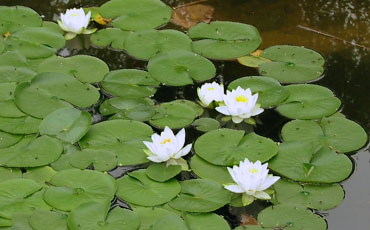
Other flour made from wild plants
Rautavaara recommends to mix 15-25% of dried leaves of White Dead nettle (Lamium album) with grain. Bread made of that mixture raises well and stays fresh longer (p.123). Dried, crushed Nettle is mixed to bread flour even today. You get bread that is friendly for your stomach if you add 10% linen seeds into the flour (HS.17.11.94). Linen seeds got a mild taste, like nuts. Aalto bakes crackers from Birch stamen catkins and makes sweet cakes from the pollen of Common Cattail (Typha latifolia).
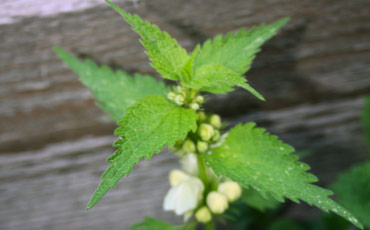
Flavours from the nature
Slightly toasted nuts give a special taste to bread and porridge. Flowers of Clover got a taste that reminds of nuts or almonds. Anneli Schöneck recommends to flavour leavened rye bread with dried, soaked Rowan-berries or nuts. Aalto recommends the use of dried wild Strawberries instead of raisins. Roasted seeds of nettle give a good taste to bread (Israelsson). Smartweed seeds have a mild bitter taste: they are a tasty adding into porridge. In the Iron-Age peas (pisum) were baked into bread.
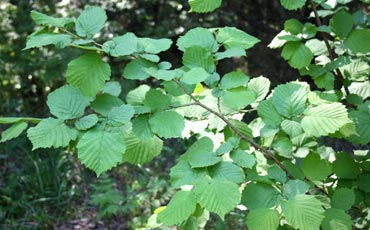
Bark flour
During famines people had to mix bread flour with some ingredients that we would imagine to be less tasty, such as Moss, straw and the bark of Pine (Uusivirta). According to Aaltonen (p.183) bark of Juniper, Beech, Willow, Birch, Aspen, Alnus and Maple could be used as well. They are even easier to use than Pine: Pine bark gum is the only one that has a bitter taste. This can be taken away by heating. Barks of the other trees can be dried and crushed into flour without heating. Even during the years of good harvest the amount of grain flour was habitally increased by adding bark into it. Sometimes famine years came so often that bread made with bark added was the everyday bread.
Up to 30% of bark in bread flour was quite normal, but during famine this could rise to 50% and even to 80%, but this much bark would create havoc to your intestines. Tribes from Siberia and American indians also used tree bark in their nutrition. (p.183).
I have seen writings where bread made with bark is considered very healthy (HS 11.2.97 and Itä-Helsingin uutiset) and even found to be tasty. Bark includes very big amount of C-vitamin and it averts UV- radiance. It also includes plenty of iron and mangnesium.The right time to take the bark off from the trees is a couple of weeks before midsummer. A pine is felled and the bark is cut in square sheets, which are to take away. Brown and green bark is thrown away, only the white part is saved. When heating or cooking most of the bitter tasting parts disappear. After heating the pine bark it is to be dried, and then the bark is crashed. A good bark flour is brownish red by color and has no taste of gum. A small pine can produce one kilogram of flour (Itä-Helsingin uutiset).
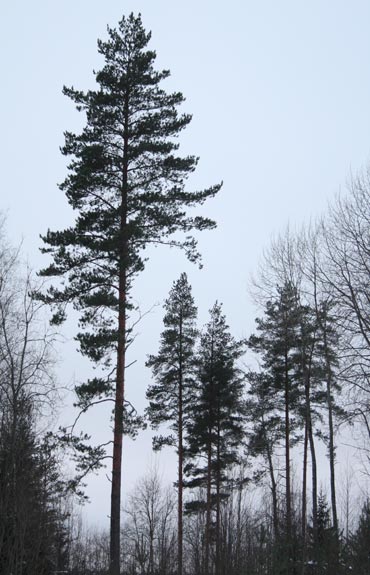
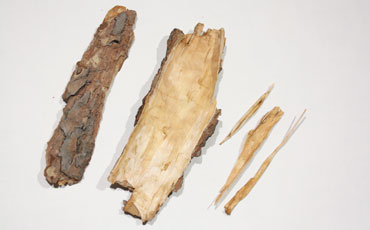
Bibliography
Aaltonen, Turkka & Arkko, Matti: Yrttiopas, luonnonkasvit ravintona. Suomen matkailuliitto, 1986
Berger, Christian & DuboË- Laurence. Philippe: Oluen ystävän opas.Otava
Birkebaek: Oldtiden I, Vikingatiden.
Blamey, Marjorie & Grey-Wilson, Christopher: Otavan kasvitieto. Skotlanti, 1994
Dembinska, Maria: Food and Drink in Medieval Poland. University of Pennysylvania press, 1999
Genrup, Kurt: Mat som Kultur; Etnologiska kosthållstudier. Tidskrift för nordskandinavisk etnologi vol 5, Umeå Universitet 1988
Hagen, Ann: a Handbook of Anglo-Saxon Food, Processing and Consumption. Anglo-Saxon books, 1994
Hagen, Ann: a Handbook of Anglo-Saxon food, Production & Distribution. Anglo-Saxon books, 1995
Hess, Karen: Martha Washington’s Booke of Cookery. Columbia University Press, 1981
Israelsson, Isse: Mat på forntida vis, ide och receptsamling; Malmö museer (also published in Forntida teknik 2/89-1/90 as Forntida mat)
Johansson, Tomas: Att ätä som en stenåldersjägare; Forntida Teknik
Jäntti & Olkinuora: Tähkäpää, luomuleipojan käsikirja
Kulturhistorisk lexikon för nordisk medeltid; Akademiska bokhandeln 1976
Kytövuori, Pirjo & Hopsu-Neuvonen, Arja: Kanankaalista karpaloon, luonnonruokaa keväästä syksyyn. Marttaliitto ry 1995
Lampinen: Ruokaleipä ja sen valmistus
Moberg; Min svenska historia, det dagliga barkbrödet
Namez, Milton: Searching for a Structure in the Late Iron Age Settlement of the Åland Islands, Finland, Karhunhammas 15/1993
Rautavaara, Tapio; Mihin kasvimme kelpaavat, ruokaa, ryytiä ja rohtoa luonnosta, WSOY 1976
Retkeilykasvio. Suomen luonnonsuojelun tuki oy. Helsinki, 1984
Rousi, Arne: Auringonkukasta viiniköynnökseen, ravintokasvit, WSOY 1997
Sass, Lorna: Christmas Feasts from History.The Metropolitan Museum of Art, 1981
Schöneck, Annelies: Leipä, Hermes Oy, 1983
Seppä-Heikka, Merja: Esihistoriallisia siemeniä ja kasvipainanteita Paimion Sievolan myöhäisrautakautiselta asuinpaikalta.
Simonetti, Gualtiero: Makujen maailma, yrtit ja mausteet. Kolibri, 1990
Stead, Bourke ja Brothwell: Lindow Man the Body in the Bog; British Museum Publications, 1986
Storck, John & Teague, Walter Dorwin: Flour For Man’s Bread; A History of milling. Oxford University Press, 1952
Suominen, Juha & Hämet-Ahti, Leena: Kasvistomme muinaistulokkaat, tulkintaa ja perusteluja, Vammala 1993
Thunaeus, Harald: Mjödet genom tiderna. Daedalus 1954
Tolonen, Mirjami: Cereal Cultivation with Particular Reference to Rye: Some Aspects on Pollen-analytical Records from Sw. Finland; Fennoscandia Archaelogica II, Suomen arkeologinen seura, 1985
Uusivirta, Hilkka: Suomalaisen ruokaperinteen keittokirja, WSOY 1982
Vehviläinen, Olli: Hiivan tarina
Viklund, Karin: Bröd, gröt och öl i forntiden; Aktuellt 93, Forntida teknik 1/93
Wilson, Anne C.: Food and Drink in Britain From the Stone Age to recent times.Penquin Books, 1084
Articles:
Bengtsson, Niklas: Elämän ja kuoleman eliksiirejä. HS 3.4.1997
Mannerkorpi, Jukka: Hunajaleipuri johtaa onneen; HS 3
Masonen, Jaakko: Maistui olut ennenkin. Tiede 2000 4/1992
Mausteet ehkäisevät homehtumista, Pirkka 1-2/96
Pakarinen, Aila: Kaalin hapattaminen sujuu aloittelijalta. HS
Skaarup, Bi: Sources of Medieval Cuisine in Denmark. In: Du manuscrit à la table, direct. Carole Lambert. Canada, 1992
Suomalaisille tarjotaan jälleen nälkämaan leipää; Itä-Helsingin Uutiset 27.3.1993
Tahkolahti, Jaakko: Pettu onkin terveellistä ja torjuu myös UV-säteilyn; HS 11.2.1997
Toiviainen, Lauri: Oluenpanosta todisteita jo 5000 vuoden takaa. HS 5.12.1992
Uudelleen keksitty pellava maustaa lakritsin ja sämpylän; HS 17.11.1994
HS= Helsingin Sanomat
Classes:
Vilkuna, Anna-Maija: Ruokatalous Hämeen linnassa 1500-luvulla. (Food Consumption in 16th century Häme castle) Suomen muinaismuistoyhdistys 4.12.1997
Conversations:
Linturi, Elsa. Archaeologist, University of Helsinki. 1998